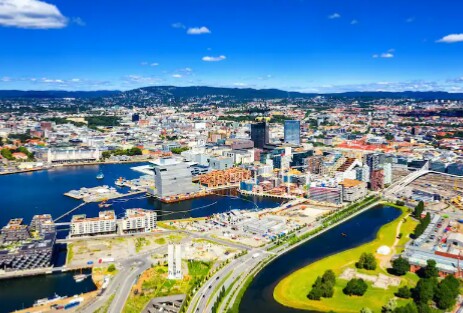Sustainable Transportation
Oslo, Norway: Pioneering Sustainability in a Vibrant City
Nestled amidst breathtaking natural landscapes, Oslo, Norway shines as a beacon of sustainable living in a vibrant urban setting. This remarkable city has forged a path towards a greener future, pioneering innovative solutions and setting new benchmarks for sustainability.
At the forefront of Oslo’s sustainability efforts is its unwavering commitment to renewable energy. The city has harnessed its abundant natural resources, leveraging hydroelectric power and embracing wind energy to drastically reduce its carbon footprint. Oslo’s ambitious goal of becoming carbon neutral by 2030 is a testament to its dedication to combating climate change.
Transportation plays a vital role in Oslo’s sustainable transformation. The city has revolutionized urban mobility by prioritizing pedestrians, cyclists, and public transportation. A well-connected network of electric buses, trams, and subways crisscrosses the city, providing efficient and eco-friendly options for daily commuters. Oslo’s emphasis on active transportation has not only reduced congestion and air pollution but also fostered a healthier lifestyle for its residents.
Oslo’s commitment to sustainability extends beyond energy and transportation. The city has embraced sustainable urban planning and architecture, blending seamlessly with its picturesque surroundings. From energy-efficient buildings and green roofs to innovative waste management systems, Oslo consistently strives to minimize its ecological footprint while maximizing quality of life.
An integral part of Oslo’s sustainable vision is its dedication to preserving and enhancing green spaces. The city boasts an impressive network of parks, forests, and waterfronts, allowing residents and visitors to connect with nature and enjoy recreational activities. Oslo’s commitment to biodiversity conservation is evident in its protected areas and efforts to restore and revitalize natural habitats.
Moreover, Oslo fosters a culture of innovation and collaboration. The city actively engages in research, knowledge-sharing, and partnerships with international organizations and fellow sustainable cities. By working together, Oslo aims to accelerate progress and inspire global change towards a more sustainable future.
Oslo, Norway stands as a pioneering city that combines sustainability and vibrancy seamlessly. Its commitment to renewable energy, sustainable transportation, green spaces, and collaborative initiatives sets an inspiring example for cities worldwide. Oslo proves that it is possible to achieve a harmonious balance between urban development and environmental preservation, creating a city where residents thrive and nature thrives alongside them.
Oslo, Sustainability in a Vibrant City
Oslo, the capital city of Norway, has emerged as a global leader in sustainable urban development. With its unwavering commitment to environmental stewardship and innovative solutions, Oslo has become a shining example of a sustainable city.
In this article, we will delve into the initiatives and practices that have propelled Oslo towards its goal of becoming carbon-neutral by 2030. Join us as we explore how Oslo’s sustainable strategies, from renewable energy to eco-friendly transportation, are transforming the city and inspiring others worldwide.
1. Renewable Energy Revolution
Oslo has embraced renewable energy sources as a cornerstone of its sustainability journey. The city has invested in hydropower, wind farms, and solar energy to meet its electricity demands sustainably. Moreover, Oslo’s district heating system harnesses excess heat from industries and converts it into energy, effectively reducing greenhouse gas emissions. By prioritizing renewable energy, Oslo has taken significant strides towards minimizing its carbon footprint and setting a positive example for other cities to follow.
2. Sustainable Transportation
Oslo has made substantial progress in creating a sustainable transportation system. The city aims to prioritize public transportation, cycling, and walking over private cars. Investments in a comprehensive network of electric buses, trams, and trains have significantly reduced emissions from public transport. Additionally, Oslo offers extensive cycling infrastructure, encouraging residents to choose eco-friendly modes of transportation. The city’s commitment to electric vehicles is evident in its vast network of charging stations and incentives for EV owners.
3. Green Spaces and Biodiversity
Preserving green spaces and promoting biodiversity are integral aspects of Oslo’s sustainable vision. The city places great emphasis on maintaining and expanding its parks, forests, and urban green areas. Oslo’s dedication to biodiversity is evident in the creation of wildlife habitats and the cultivation of urban gardens. These green spaces not only enhance the quality of life for residents but also contribute to climate regulation and support a healthy ecosystem.
4. Circular Economy Initiatives
Oslo has embraced the concept of a circular economy, striving to minimize waste and maximize resource efficiency. The city promotes sustainable consumption and waste reduction through innovative strategies such as recycling, upcycling, and repair initiatives. Oslo’s focus on sustainable procurement encourages businesses to adopt environmentally friendly practices, thereby creating a ripple effect throughout the supply chain. By embracing circular economy principles, Oslo is reducing its ecological footprint and fostering a more sustainable future.
5. Eco-Friendly Architecture
Oslo’s architecture reflects its commitment to sustainability. The city has implemented strict energy efficiency standards for buildings, resulting in the construction of eco-friendly structures. Many buildings in Oslo incorporate green roofs, solar panels, and energy-efficient systems to minimize energy consumption. The use of sustainable materials, such as timber, further reduces the environmental impact of construction. Oslo’s architectural landscape not only harmonizes with the natural surroundings but also serves as a testament to the city’s dedication to sustainable living.
Conclusion for Oslo, Norway: Pioneering Sustainability in a Vibrant City
Oslo, Norway, stands as a trailblazer in the global sustainability movement. Through its initiatives in renewable energy, sustainable transportation, green spaces, circular economy practices, and eco-friendly architecture, Oslo has set a high bar for other cities worldwide.
With its ambitious goal of achieving carbon neutrality by 2030, Oslo showcases the power of innovation and collective action in creating a sustainable future. As cities around the world strive to emulate Oslo’s success, the Norwegian capital serves as an inspiring model and a testament to the transformative impact of sustainable practices.
Oslo, Norway stands as a pioneering city that sets the standard for sustainability in a vibrant urban environment. With its forward-thinking initiatives and commitment to environmental stewardship, Oslo has emerged as a global leader in sustainable development.
Through a holistic approach, Oslo has successfully integrated sustainability into various aspects of city life. The city’s strong focus on renewable energy has resulted in a significant reduction in carbon emissions, with ambitious goals to become carbon neutral by 2030. Oslo’s extensive public transportation network, including electric buses and trams, promotes eco-friendly mobility options and reduces reliance on private vehicles.
One of Oslo’s notable achievements is its dedication to green spaces and biodiversity. The city places a high emphasis on preserving and expanding urban parks, forests, and waterfront areas, providing residents and visitors with ample opportunities to connect with nature. Oslo’s commitment to sustainable architecture is evident in its eco-friendly buildings, which prioritize energy efficiency and utilize innovative design concepts.
Furthermore, Oslo has embraced circular economy principles, focusing on waste reduction, recycling, and resource efficiency. The city’s waste management system encourages proper sorting and recycling practices, contributing to a circular and sustainable economy.
Oslo’s sustainability efforts extend beyond its borders through international collaborations and knowledge sharing. The city actively participates in global networks and initiatives to exchange best practices and drive collective action towards a more sustainable future.
As a result of these initiatives, Oslo has achieved an impressive balance between urban development and environmental preservation. The city’s commitment to sustainability not only enhances the quality of life for its residents but also serves as an inspiration for other cities around the world.
In conclusion, Oslo, Norway’s pioneering spirit in promoting sustainability within a vibrant city sets a remarkable example for urban centers globally. By prioritizing renewable energy, eco-friendly transportation, green spaces, circular economy practices, and international collaboration, Oslo demonstrates that sustainable development is achievable without compromising the vitality and liveliness of a city. Oslo’s journey towards a greener future serves as a source of inspiration and a blueprint for other cities to follow in the pursuit of a sustainable and thriving urban environment.
https://www.exaputra.com/2023/06/oslo-norway-pioneering-sustainability.html
Renewable Energy
Before Trump, “Contempt of Court” Used to Be a Big Deal
 Most Americans, me included, are puzzled as to how the Trump administration can openly thumb its nose to the findings of our courts. Until recently, behavior like this would have wound you up in jail.
Most Americans, me included, are puzzled as to how the Trump administration can openly thumb its nose to the findings of our courts. Until recently, behavior like this would have wound you up in jail.
Renewable Energy
How Households Saved $1,200 with VEU & Air-Con Upgrade?
Renewable Energy
Air Power
 About 20 years ago, a friend asked me if I was aware that cars could run on air. I asked, delicately, what she meant, and she explained that cars can run on compressed air.
About 20 years ago, a friend asked me if I was aware that cars could run on air. I asked, delicately, what she meant, and she explained that cars can run on compressed air.
“Ah,” I replied. “Of course they can. But where does the energy come from that compresses the air?” End of conversation.
Now, it’s back. Now there are enormous swaths of the population who know so little about middle school science that they believe we can put cars on the road, in an ocean of air, and extract energy out of that air to power our automobiles.
If you’re among these morons and want to invest with some heavy-duty fraud/charlatans, here’s your opportunity. They say that it’s “self-sustaining and needs no fuel.” If that makes sense to you, be my guest.
-
Climate Change4 months ago
Guest post: Why China is still building new coal – and when it might stop
-
Greenhouse Gases4 months ago
Guest post: Why China is still building new coal – and when it might stop
-
Climate Change2 years ago
Spanish-language misinformation on renewable energy spreads online, report shows
-

 Greenhouse Gases2 years ago
Greenhouse Gases2 years ago嘉宾来稿:满足中国增长的用电需求 光伏加储能“比新建煤电更实惠”
-
Climate Change Videos2 years ago
The toxic gas flares fuelling Nigeria’s climate change – BBC News
-

 Climate Change2 years ago
Climate Change2 years ago嘉宾来稿:满足中国增长的用电需求 光伏加储能“比新建煤电更实惠”
-

 Carbon Footprint2 years ago
Carbon Footprint2 years agoUS SEC’s Climate Disclosure Rules Spur Renewed Interest in Carbon Credits
-
Renewable Energy5 months ago
US Grid Strain, Possible Allete Sale















